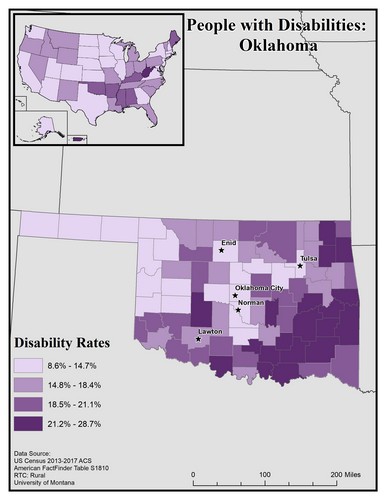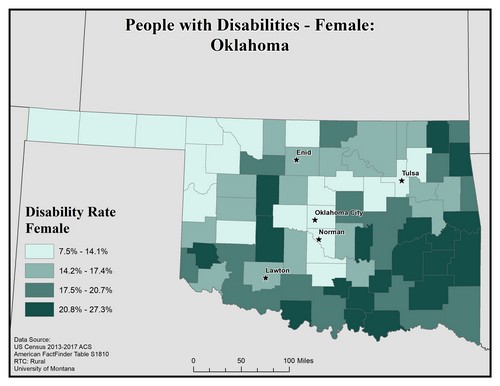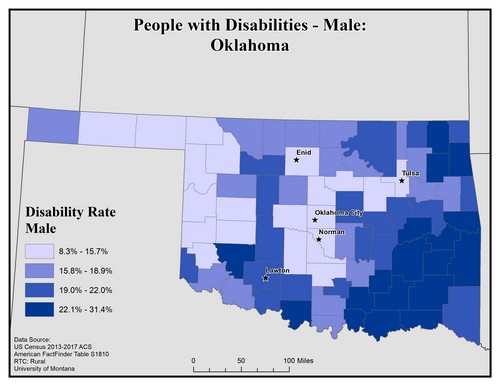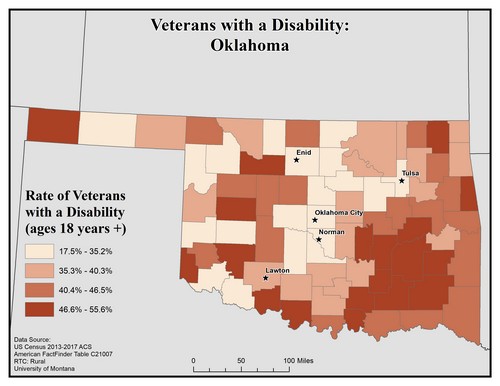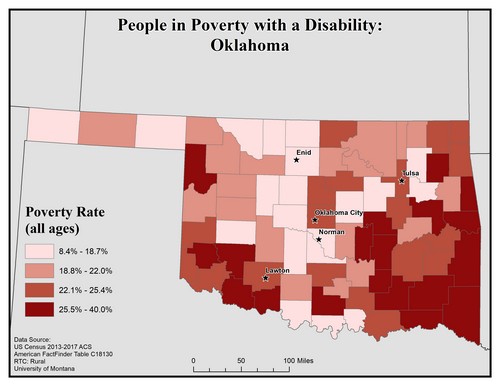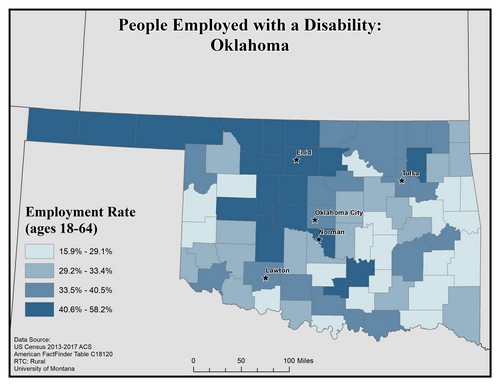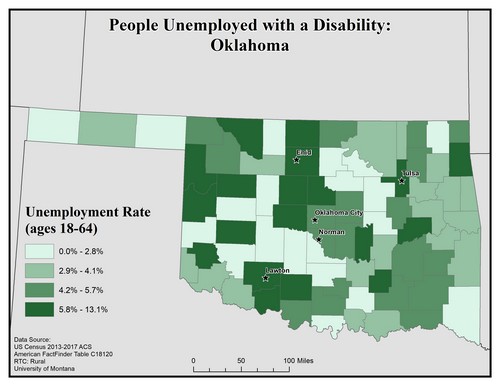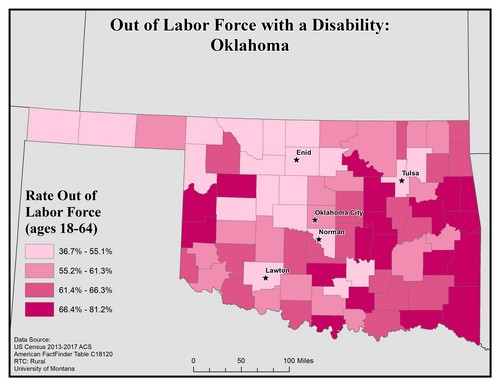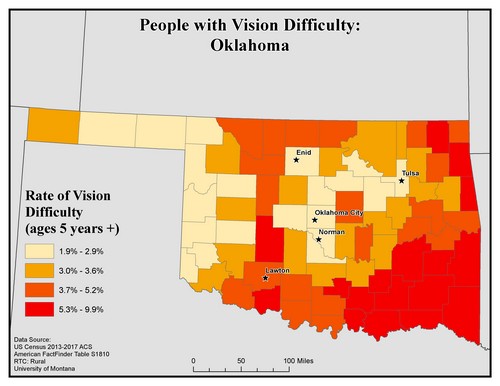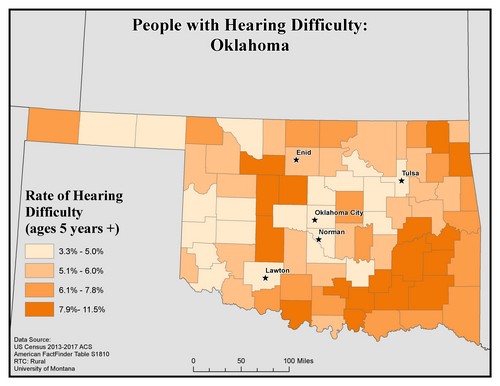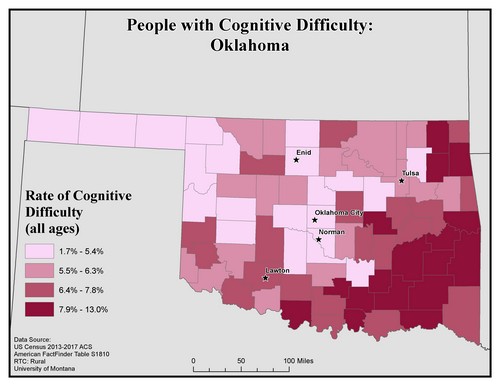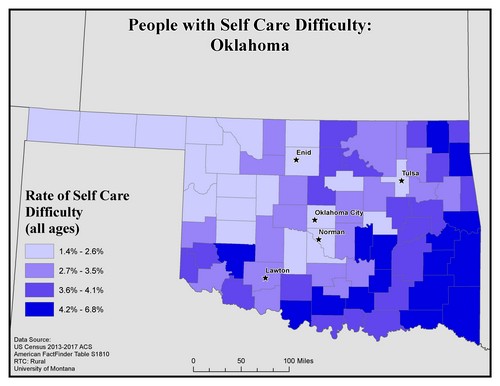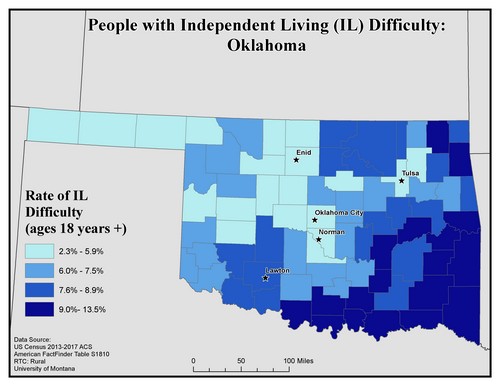Oklahoma State Profile
The maps on this page explore the American Community Survey 5-year data (Table S1810) on disability by county.
The ACS does not directly measure disability. Instead, it uses a set of disability indicator questions related to difficulty and functional impairment to identify individuals who may experience a disability. If a respondent can answer “yes” to any disability question they are classified as having a disability.
Disability Rates: Oklahoma
This map of the state of Oklahoma shows general rates of disability by county. Disability rates are broken into four levels: 8.6 to 14.7%, 14.8 to 18.4%, 18.5 to 21.1%, and 21.2 to 28.7%.
The five largest urban areas (Lawton, Enid, Oklahoma City, Norman, and Tulsa) are labeled on the map to show if there are any differences between disability rates in urban compared to rural areas. Rates are variable across the state. Counties with the highest rates (21.2 to 28.7%) are primarily rural, and located in the southeastern corner of the state. Rural counties in the panhandle and western side of the state have the lowest rates, as do the urban counties containing the major urban areas.
In the upper corner there is an inset map of the United States showing how overall general disability rates in Oklahoma compare to other states. Overall, disability rates in Oklahoma are in the second-highest category, which means Oklahoma has rates of disability higher than many other states, and has similarity to Arkansas, Mississippi, and Alabama.
Map produced October 2019 based on 2013-2017 American Community Survey data.
- Click on the map for a larger, downloadable version.
- To browse or download the data used to make this map, use our Disability Data Lookup Tool.
This map of the state of Oklahoma shows disability rate among females by county. Rates are broken into four categories from 7.5 to 27.3%.
The five largest urban areas (Lawton, Enid, Oklahoma City, Norman, and Tulsa) are labeled on the map to show if there are any differences between rates in urban compared to rural areas.
Oklahoma City, Norman and Tulsa are in counties with the lowest rate of 7.5 to 14.1%. Enid and Lawton are in counties with the second-lowest rate of 14.2 to 17.4%.
Map produced June 2020 based on 2013-2017 American Community Survey data.
- Click on the map for a larger, downloadable version.
- To browse or download the data used to make this map, use our Disability Data Lookup Tool.
- For information on how biological sex is used and defined in the ACS, see “American Community Survey and Puerto Rico Community Survey 2017 Subject Definitions” page 125.
This map of the state of Oklahoma shows disability rate among males by county. Rates are broken into four categories from 8.3% to 31.4%.
Lawton is in a county with the second-highest rate of 19.0 to 22.0%. The other four cities are in counties with the lowest rate of 8.3 to 15.7%.
Map produced June 2020 based on 2013-2017 American Community Survey data.
- Click on the map for a larger, downloadable version.
- To browse or download the data used to make this map, use our Disability Data Lookup Tool.
- For information on how biological sex is used and defined in the ACS, see “American Community Survey and Puerto Rico Community Survey 2017 Subject Definitions” page 125.
This map explores the American Community Survey (ACS) 5-year data (Table S1810) on disability estimates.
The ACS asks a set of disability indicator questions to determine disability. If a respondent can answer “yes” to any disability question they are classified as having a disability. The data below are for ages 18 and over.
This map of the state of Oklahoma shows rates of disability among veterans aged 18 and older by county. Rates are broken into four categories from 17.5 to 55.6%.
The five largest urban areas (Lawton, Enid, Oklahoma City, Norman, and Tulsa) are labeled on the map to show if there are any differences between rates in urban compared to rural areas.
Lawton is in a county with the second-lowest rate of 35.3 to 40.3%. The other four cities are in counties with the lowest rate of 17.5 to 35.2%.
Map produced June 2020 based on 2013-2017 American Community Survey data.
- Click on the map for a larger, downloadable version.
- To browse or download the data used to make this map, use our Disability Data Lookup Tool.
This map of the state of Oklahoma shows poverty rates among people with disabilities of all ages by county. Poverty rates are broken into four levels from 8.4 to 40.0%.
The five largest urban areas (Lawton, Enid, Oklahoma City, Norman, and Tulsa) are labeled on the map to show if there are any differences between rates in urban compared to rural areas.
Norman and Enid are in counties with the lowest rate of 8.4 to 18.7%. Lawton, Oklahoma City and Tulsa are in counties with the second-highest rate of 22.1 to 25.4%.
Map produced June 2020 based on 2013-2017 American Community Survey data.
- Click on the map for a larger, downloadable version.
- To browse or download the data used to make this map, use our Disability Data Lookup Tool.
Employment: Oklahoma
This map explores American Community Survey (ACS) 5-year data (Table C18120) employment estimates by disability type.
The ACS asks a set of disability indicator questions to determine disability. If a respondent can answer “yes” to any disability question they are classified as having a disability. The data below are for ages 18-64.
This map of Oklahoma shows employment rates among people with disabilities. The data includes people ages 18 to 64. Rates are broken into four categories ranging from 15.9 to 58.2%.
The five largest urban areas (Lawton, Enid, Oklahoma City, Norman, and Tulsa) are labeled on the map to show if there are any differences between rates in urban compared to rural areas.
Tulsa, Oklahoma City, and Lawton are in counties with the second-highest rate of 33.5 to 40.5%. Enid and Norman are in counties with the highest rate of 40.6 to 58.2%.
Map produced June 2020 based on 2013-2017 American Community Survey data.
- Click on the map for a larger, downloadable version.
- To browse or download the data used to make this map, use our Disability Data Lookup Tool.
This map explores American Community Survey (ACS) 5-year data (Table C18120) employment estimates by disability type.
The ACS asks a set of disability indicator questions to determine disability. If a respondent can answer “yes” to any disability question they are classified as having a disability. The data below are for ages 18-64.
This map of Oklahoma shows unemployment rates among people with disabilities. The data includes people ages 18 to 64. Rates are broken into four categories from 0.0 to 13.1%.
The five largest urban areas (Lawton, Enid, Oklahoma City, Norman, and Tulsa) are labeled on the map to show if there are any differences between rates in urban compared to rural areas.
Norman and Oklahoma City are in counties with the second-highest rate of 4.2 to 5.7%. Enid, Lawton, and Tulsa are in counties with the highest rate of 5.8 to 13.1%.
Map produced June 2020 based on 2013-2017 American Community Survey data.
- Click on the map for a larger, downloadable version.
- To browse or download the data used to make this map, use our Disability Data Lookup Tool.
This map explores American Community Survey (ACS) 5-year data (Table C18120) employment estimates by disability type.
The ACS asks a set of disability indicator questions to determine disability. If a respondent can answer “yes” to any disability question they are classified as having a disability. The data below are for ages 18-64.
This map of Oklahoma shows out of labor force rates among people with disabilities. The data includes people ages 18 to 64. Rates are broken into four categories from 36.7 to 81.2%.
The five largest urban areas (Lawton, Enid, Oklahoma City, Norman, and Tulsa) are labeled on the map to show if there are any differences between rates in urban compared to rural areas.
Oklahoma City is in a county with the second-lowest rate of 55.2 to 61.3%. The other four cities are in counties with the lowest rate of 36.7 to 55.1%.
Map produced June 2020 based on 2013-2017 American Community Survey data.
- Click on the map for a larger, downloadable version.
- To browse or download the data used to make this map, use our Disability Data Lookup Tool.
Disability Rates by Functional Limitation: Oklahoma
This map explores the American Community Survey (ACS) 5-year data (Table S1810) on disability estimates by county.
For vision difficulty the ACS asks if a respondent is blind or has serious difficulty seeing, even when wearing glasses. If they answer “yes” they are classified as having a vision difficulty. This data is for all ages.
This map of the state of Oklahoma shows rates of people with vision difficulty for ages 5 and older by county. Rates are broken into four categories from 1.9 to 9.9%.
The five largest urban areas (Lawton, Enid, Oklahoma City, Norman, and Tulsa) are labeled on the map to show if there are any differences between rates in urban compared to rural areas.
Lawton is in a county with the second-highest rates of 3.7 to 5.2%. The other four cities are in counties with the lowest rate of 1.9 to 2.9%.
There is a pocket of counties in the southeast corner of the state with the highest rate of 5.3 to 9.9%.
Map produced April 2020 based on 2013-2017 American Community Survey data.
- Click on the map for a larger, downloadable version.
- To browse or download the data used to make this map, use our Disability Data Lookup Tool.
This map explores the American Community Survey (ACS) 5-year data (Table S1810) on disability estimates by county.
For hearing difficulty the ACS asks if a respondent is deaf or has serious difficulty hearing. If they answer “yes” they are classified as having a hearing difficulty. This data is for all ages.
This map of the state of Oklahoma shows rates of people with hearing difficulty for ages 5 and older by county. Rates are broken into four categories from 3.3 to 11.5%.
The five largest urban areas (Lawton, Enid, Oklahoma City, Norman, and Tulsa) are labeled on the map to show if there are any differences between rates in urban compared to rural areas.
Enid is in a county with the second-lowest rate of 5.1 to 6.0%. The other four cities are in counties with the lowest rate of 3.3 to 5.0%.
Map produced April 2020 based on 2013-2017 American Community Survey data.
- Click on the map for a larger, downloadable version.
- To browse or download the data used to make this map, use our Disability Data Lookup Tool.
This map explores the American Community Survey (ACS) 5-year data (Table S1810) on disability estimates by county.
For cognitive difficulty the ACS asks because of a physical, mental, or emotional problem, does the respondent have difficulty remembering, concentrating, or making decisions. If they answer “yes” they are classified as having a cognitive difficulty. This data is for ages 5 and up.
This map of the state of Oklahoma shows rates of people with cognitive difficulty by county. Rates are broken into four categories from 2.3 to 13.5%.
The five largest urban areas (Lawton, Enid, Oklahoma City, Norman, and Tulsa) are labeled on the map to show if there are any differences between rates in urban compared to rural areas.
Lawton is in a county with the second-highest rate of 7.6 to 8.9%. The other four cities are in counties with the lowest rate of 2.3 to 5.9%.
Many of the counties in the southeast part of the state have the highest rate of 9.0 to 13.5%.
Map produced April 2020 based on 2013-2017 American Community Survey data.
- Click on the map for a larger, downloadable version.
- To browse or download the data used to make this map, use our Disability Data Lookup Tool.
This map explores the American Community Survey (ACS) 5-year data (Table S1810) on disability estimates by county.
For ambulatory (i.e. mobility) difficulty the ACS asks if a respondent has serious difficulty walking or climbing stairs. If they answer “yes” they are classified as having a mobility difficulty. This data is for ages 5 and up.
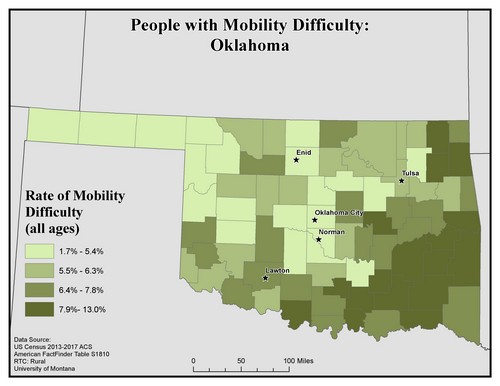 This map of the state of Oklahoma shows rates of people with mobility difficulty for all ages by county. Rates are broken into four categories from 1.7 to 13.0%.
This map of the state of Oklahoma shows rates of people with mobility difficulty for all ages by county. Rates are broken into four categories from 1.7 to 13.0%.
The five largest urban areas (Lawton, Enid, Oklahoma City, Norman, and Tulsa) are labeled on the map to show if there are any differences between rates of people with mobility difficulty in urban compared to rural areas.
Oklahoma City, Norman, and Enid are in counties with the lowest rate of 1.7 to 5.4%. Tulsa is in a county with the second-lowest rate of 5.5 to 6.3%. Lawton is in a county with the second-highest rate of 6.4 to 7.8%.
Map produced April 2020 based on 2013-2017 American Community Survey data.
- Click on the map for a larger, downloadable version.
- To browse or download the data used to make this map, use our Disability Data Lookup Tool.
This map explores the American Community Survey (ACS) 5-year data (Table S1810) on disability estimates by county.
For self-care difficulty the ACS asks if a respondent has difficulty bathing or dressing. If they answer “yes” they are classified as having a self-care difficulty. This data is for ages 5 and up.
This map of the state of Oklahoma shows rates of people with self-care difficulty by county. Rates are broken into four categories from 1.4 to 6.8%.
The five largest urban areas (Lawton, Enid, Oklahoma City, Norman, and Tulsa) are labeled on the map to show if there are any differences between rates in urban compared to rural areas.
Lawton is in a county with the second-lowest rate of 2.7 to 3.5%. The other four cities are in counties with the lowest rate of 1.4 to 2.6%.
Many counties in the south and south-east corner of the state have the highest rate of 4.2 to 6.8%.
Map produced April 2020 based on 2013-2017 American Community Survey data.
- Click on the map for a larger, downloadable version.
- To browse or download the data used to make this map, use our Disability Data Lookup Tool.
This map explores the American Community Survey (ACS) 5-year data (Table S1810) on disability estimates by county.
For independent living difficulty the ACS asks because of a physical, mental, or emotional problem, does the respondent have difficulty doing errands alone such as visiting a doctor’s office or shopping. If they answer “yes” they are classified as having an independent living difficulty. This data is for ages 18 and up.
This map of the state of Oklahoma shows rates of independent living (IL) difficulty for people 18 years of age and older by county. Rates are broken into four categories from 2.3 to 13.5%.
The five largest urban areas (Lawton, Enid, Oklahoma City, Norman, and Tulsa) are labeled on the map to show if there are any differences between rates of people with independent living difficulty in urban compared to rural areas.
Lawton is in a county with the second-highest rate of 7.6 to 8.9%. The other four cities are in counties with the lowest rate of 2.3 to 5.9%.
Many counties in the south and south-eastern part of the state have the highest rate of 9.0 to 13.5%.
Map produced April 2020 based on 2013-2017 American Community Survey data.
- Click on the map for a larger, downloadable version.
- To browse or download the data used to make this map, use our Disability Data Lookup Tool.

